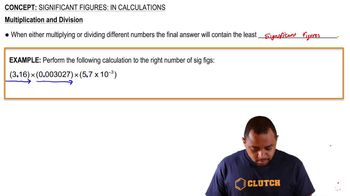Textbook Question
Which numbers are exact (and therefore have an unlimited number of significant figures)? a. π = 3.14 c. EPA gas mileage rating of 26 miles per gallon d. 1 gross = 144
1853
views
 Verified step by step guidance
Verified step by step guidance



Which numbers are exact (and therefore have an unlimited number of significant figures)? a. π = 3.14 c. EPA gas mileage rating of 26 miles per gallon d. 1 gross = 144
Which numbers are exact (and therefore have an unlimited number of significant figures)? b. 12 in = 1 ft
Round each number to three significant figures. a. 79,845.82 b. 1.5148937×107 c. 1.13499999995 d. 0.0000415389
Calculate to the correct number of significant figures. b. 2.36 * 0.09870 * 0.0341
Calculate to the correct number of significant figures. d. (1.128x105) / (2.7x102)
Calculate to the correct number of significant figures. a. 0.004 + 0.09879 b. 1239.3 + 9.73 + 3.42 c. 2.4 - 1.777